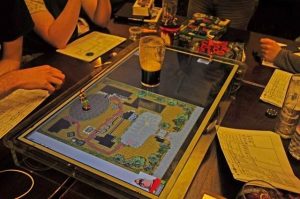Through virtual tabletop gaming one can navigate these uncharted territories represented by Lovecraft maps that bring diabolical horror to your tabletop experience. Virtual tabletop games allow users to interact with horror maps as if they came across an enigmatic gateway. From your desk position you roll dice then find yourself observing the map of Arkham and Innsmouth on the screen. From your desk you move your gaze to a cartographic representation of Arkham streets that wriggle in ways that seem unnatural.

Innsmouth exists beyond typical coastal mists due to the concealed dangers that reside beneath the sea fog. The upcoming experience promises a complete wild journey.
Virtual tabletop systems advance traditional maps even more. Tracks of blood and paths through cursed libraries along with hidden passages become visible instantly through simple computer commands. The virtual exploration allows you to function as the producer whileliving the experience of a horror film. And the actors. And probably the first victim.
Game maps created by H.P. Lovecraft function because they never give the players a specific order of events to expect. The upcoming turns of events never become predictable to anyone. A cultist’s altar? A portal to another dimension? Or just a really creepy coat rack? The possibilities are endless. And terrifying.
There exists a reality beyond the fact that every map fails to achieve masterpiece status. A few of your maps become monotonous and make playtime dull for your game participants. Two groups exist: ones who have too many details while others find themselves overwhelmed with too many specifics. What it takes is discovering the optimal level of detail. Provide enough information to ignite their creative potential yet maintain areas where something new can be discovered. Fear takes its most terrifying form inside what remains unseen to the players.
Distortions between lighting and sound quality determine whether a map succeeds or fails. When you lower the lighting the ordinary empty walkthrough turns into an alluring death pit. Distant noises added to your game will leave your players nervously surveying their surroundings. It’s all about atmosphere. Creating atmosphere stands as the most important factor within a Lovecraft game.
The matter of size creates an important dilemma. How big should the map be? A confined area feels restricted to players because of its size. An excessive size makes the area less impactful on viewers. The key is balance. Players need enough freedom to move around but uncomfortable tension must always reign. The horror effect reaches its best point when people have no possibility to escape.
All maps cannot function as nightmares because of their purpose. Even a touch of comedic relief helps the situation greatly in some cases. A cultist characters accidentally tumbles over his personal robe. The creature brings both humor and a lack of genuine terror to the mix. Keeping your players mentally active stands as the highest priority when you design your horror gaming world.
The best tool available for both experienced dungeon masters and fresh story creators becomes Lovecraft maps. They’re more than just tools. They’re gateways to another world. Imagination sets the only boundary when you enter a world beyond normal rules. The fault for seeing tentacled nightmares rests entirely with you.
